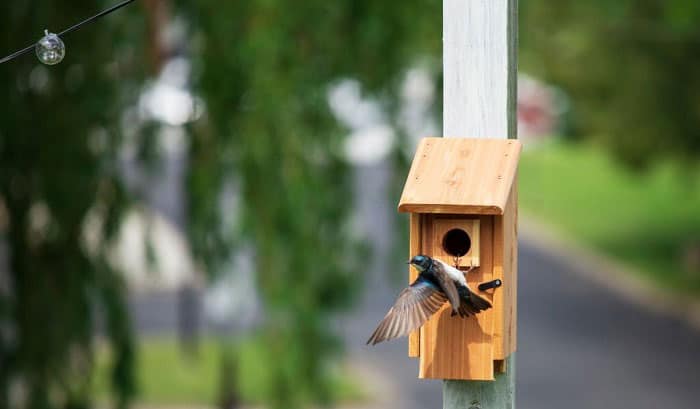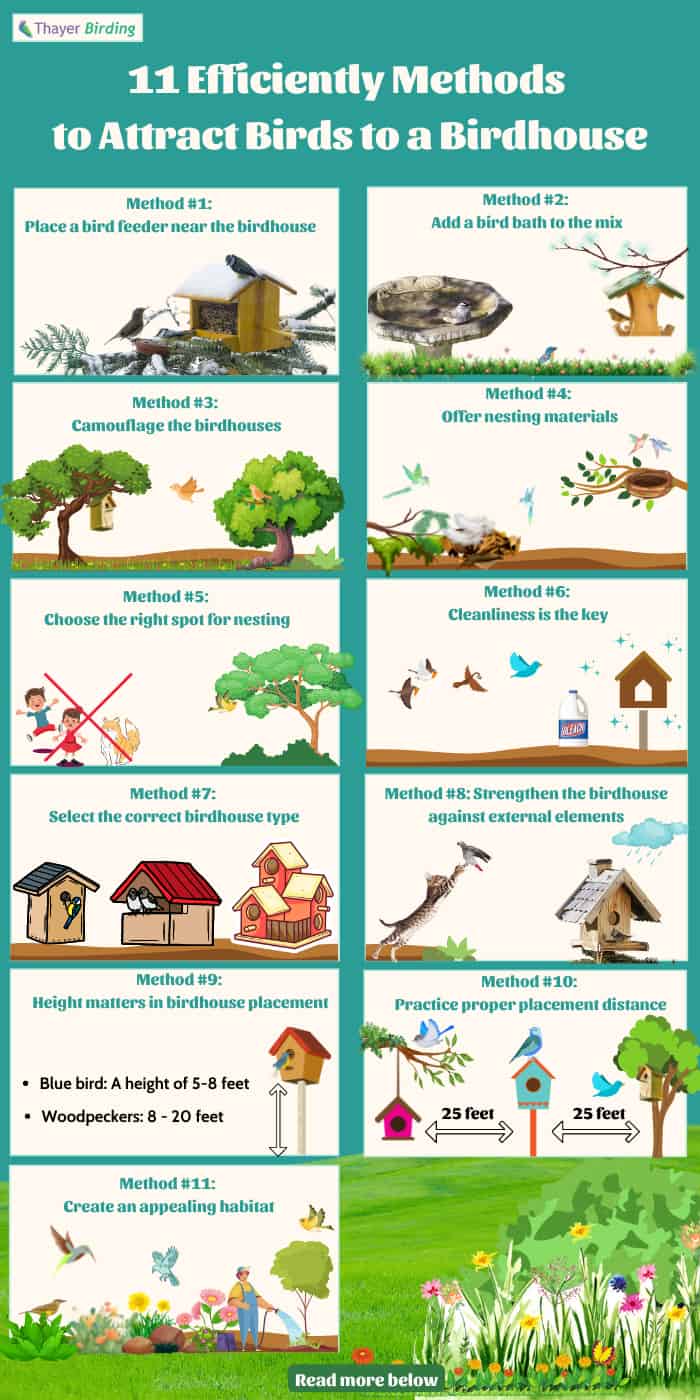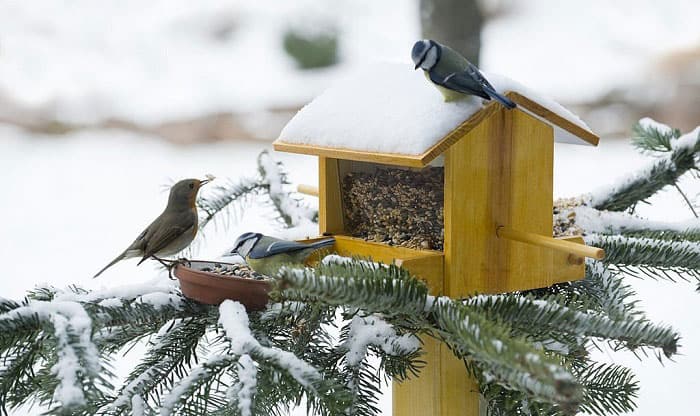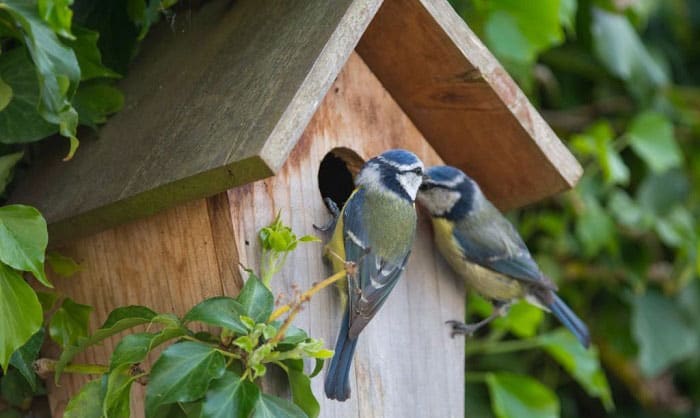Bird lovers are always fond of watching avians no matter the time of day. And as a bird enthusiast yourself, you’d want to take your hobby to the next level and invite birds to your yard.
Having birds in your property all day and night is exciting, and you can achieve this goal through a birdhouse. However, it’s essential to figure out exactly how to attract birds to a birdhouse.
Table of Contents
- How to Get Birds to Use Birdhouse
- Method #1: Place a bird feeder near the birdhouse
- Method #2: Add a bird bath to the mix
- Method #3: Camouflage the birdhouses
- Method #4: Offer nesting materials
- Method #5: Choose the right spot for nesting
- Method #6: Cleanliness is the key
- Method #7: Select the correct birdhouse type
- Method #8: Strengthen the birdhouse against external elements
- Method #9: Height matters in birdhouse placement
- Method #10: Practice proper placement distance
- Method #11: Create an appealing habitat
- Most Common Types of Birdhouses
- Conclusion
How to Get Birds to Use Birdhouse
Birdhouses are designed for nesting, but it does not mean that when you have one, the birds will come.
Keep in mind that there are many residences that have birdhouses in their yards, and the avian species are cautious creatures, so you need to work harder on finding out the ways to attract birds to a birdhouse. So come on, let’s explore your options.
Method #1: Place a bird feeder near the birdhouse
During the nesting period or winter time, the survival of the birds matters most. It is not enough that you offer the avian species with a place to stay. Food is also a crucial element in attracting birds. So it is ideal to install a bird feeder and place it near your birdhouse.
Fill the feeder with the favorite foods of avians, such as black oil sunflower, fruits, suet, mealworms, jellies, nuts, and other bird seeds. With a birdhouse and a feeder at the same time, birds have everything they need to survive.
Method #2: Add a bird bath to the mix
To effectively attract birds to a new birdhouse, it is highly recommended to place a bird bath together with the birdhouse and feeder. The avian species require fresh water for proper hydration, so a bird bath is definitely a good addition to the roosting place and feeding area.
You can also opt for a bird bath fountain for a refreshing splash on sunny days.
When your yard has a birdhouse, a bird feeder, and a bird bath, everything that the feathery creatures need to live is within their grasp. And more birds will come to enjoy your amazing yard.
Method #3: Camouflage the birdhouses
While nesting, birds are extremely protective of their nesting spots. There are many predators out there, and so camouflaging the birdhouse is helpful to provide a safe setting for the avians.
It is best to add evergreen trees, shrubs, and tree branches to the location of the birdhouse.
Method #4: Offer nesting materials
The male birds search for nesting materials during the breeding season. And if you want to drive the avian species to your birdhouse, a great method would be to provide the birds with the nesting materials to build their nests.
Allocate a space near your birdhouse for placing twigs, mosses, dead leaves, bark strips, feathers, dry grass, pine needles, and plant tuff.
By offering the nesting items to the birds, you’re helping them start their family. And since they already have what they need for nest building, then they are likely to use your birdhouse.
Method #5: Choose the right spot for nesting
Birds that use birdhouses are often nesting. Hence, in order to attract the avians to build a family in your birdhouse, you must give them the right spot for this activity.
Select a place that is far from rowdy children, and not accessible to predators such as house cats. It’s also ideal to choose a spot where it’s quiet because birds get easily spooked with loud noises.
Method #6: Cleanliness is the key
Birds are more likely to visit a clean birdhouse compared to a dirty one. That’s why it is essential to always clean the birdhouse once the avians leave.
Remove all remnants of bird occupation. Use bleach and water for sanitization, and get the birdhouse ready for the next occupants.
Method #7: Select the correct birdhouse type
In your quest to lure birds, understand that the type of birdhouse plays a huge role. There are birds that prefer multi-unit birdhouses to form a community, while solitary birds opt for single-unit birdhouses.
Another rule of thumb is the smaller the birds, the smaller the entry point, and the same goes for large birds. Perform research on what kind of bird you want to attract, and what entrance hole fits them.
Method #8: Strengthen the birdhouse against external elements
No matter what type of bird boxes for different birds you will choose, you must pay close attention to the structural design. Birds are quite picky, and they favor birdhouses with an overhang roof that protects them from the rain.
The interior needs to be devoid of paint; the walls must be strong and not easily breached by predators and the weather; there must be proper air flow, and there should be drainage holes.
And so in buying a new birdhouse, choose a design that safeguards the birds from the outside elements.
Method #9: Height matters in birdhouse placement
The height of the birdhouse from the ground matters, especially if you have a specific bird in mind. If you want to attract bluebirds, mount the birdhouse at a height of 5-8 feet, while for woodpeckers, 8 to 20 feet is best.
Generally, for a safe enough height, opt for 5 feet from the earth. This is enough height to prevent predators like squirrels and cats from reaching the nesting birds.
Method #10: Practice proper placement distance
If your goal is to entice different bird species, then it’s best to place various kinds of birdhouses. But of course, create proper spacing in their placements.
Take note that birds are territorial by nature, and so if you place multiple birdhouses in close proximity, the avian species may refuse to move in.
The general rule is to create a 25 feet space between each birdhouse.
Method #11: Create an appealing habitat
Birds are naturally attracted to trees, shrubs, and plants. And so it’s ideal to have plants in your yard. However, trees take years to grow, and you may not be a fan of shrubberies.
If this is the case, then a beautiful garden is a great choice. With plants and flowers growing in your yard, the birds are more likely to visit your birdhouse.
Most Common Types of Birdhouses
- Post-mounted birdhouses – These are freestanding birdhouses that are ideal for a yard with no trees. They are mounted on a pole where the birdhouse is high in the air. This kind of a birdhouse is a space saver, and cleaner as well.
- Swinging birdhouses – These hanging birdhouses are very easy to use. You can hang the birdhouse under your roof or a tree.
- By using this kind of structure, you can keep the avians closer to home, especially if you place the swinging birdhouse on your porch or outside your window.
- Wall-mounted birdhouses – They are perfect for mounting on trees and fences, and can be of varying heights.
- The wall-mounted birdhouses are crafted with a hook at the back for seamless mounting. They are durable and very common.
- Single-unit nest boxes – These are birdhouses that are designed for a single family of birds only. This type works for territorial avians, and usually there is only one small entry point.
- Multiple-units birdhouses – Many bird species prefer to belong to a community, and a multiple-unit birdhouse is perfect for them.
- These birdhouses have multiple entrances to allow a group of birds to roost or nest together. Of course, these structures are typically large.
- Gourd birdhouses – Birds like nuthatches, wrens, bluebirds, chickadees, and swallows prefer the gourd birdhouses. They are crafted using heavy-duty shelled fruits, and are best mounted in a tree or a pole.
- Decorative birdhouses – These birdhouses are designed to appear beautiful. They are crafted with various materials and beautified with paint, glitz, and other decorative items. They are not really effective in attracting birds, but a few may come once in a while.
Indeed, there are different options when it comes to birdhouses. Another factor that must be considered in selecting a birdhouse is the material.
The most common materials for birdhouses are ceramic, plastic, wood, metal, resin, fabric, and gourd.
Conclusion
There are a variety of efficacious methods on how to attract birds to a birdhouse. By following the techniques that are featured in this post, more and more birds will surely move into the home you gave them.
In selecting the best birdhouses for your yard, always consider the type, design, and materials of the birdhouse.
Kindly share this post to your friends, and leave us your comments. We really love to hear from you.

George and I became friends after a birdwatching trip with our new group. And we have been enjoying every adventure together. When he told me the idea of establishing a site that shares our experiences and fun, I immediately agreed. After trials and errors, here we have Thayerbirding.

















